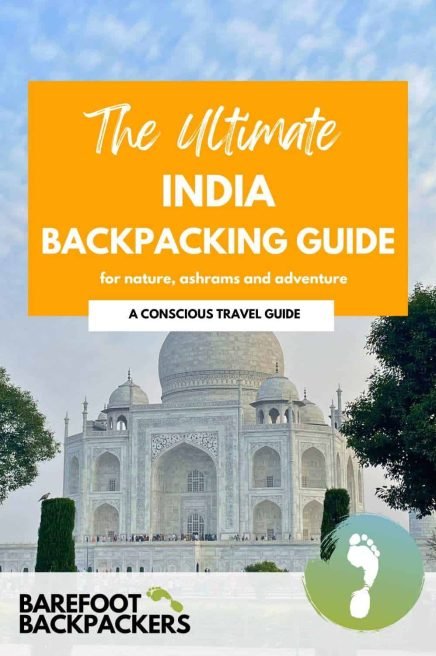Welcome to our India for backpackers guide. When it comes to backpacking, some countries are easy to navigate. They ease you in; there is a clear backpacker route with sights and a happy hour. India? Well, India is a different experience. It throws you into the deep end, and there is a real sensory overload. It is a full-spectrum experience, a country of contradictions and colour, of beautiful chaos and peace. If backpacking had difficulty settings, India would be hard mode. And yet, it is one of those places you know you will visit time and again.
We spent over three months travelling our way through India, from the southern states to the Himalayas. From remote ashrams to ancient temples, beaches to backwaters, we intended to stay at least one week in each area and go to places that were all about nature and spirituality.
Read more: 10 Best Spiritual Retreats in India 2025
This is our Barefoot Backpackers guide to India, a mix of conscious travel, yoga, Ayurveda, and nature-based adventures. Whether you are here to wake up at sunrise for Satsang, catch the sunrise on a Goan beach, or just soak in ancient sites from temple walls, India will teach you, stretch you, and invite you to grow in ways you never expected. We will talk about how much things cost, the budget, top sights, and a Google Maps of our three-month route.
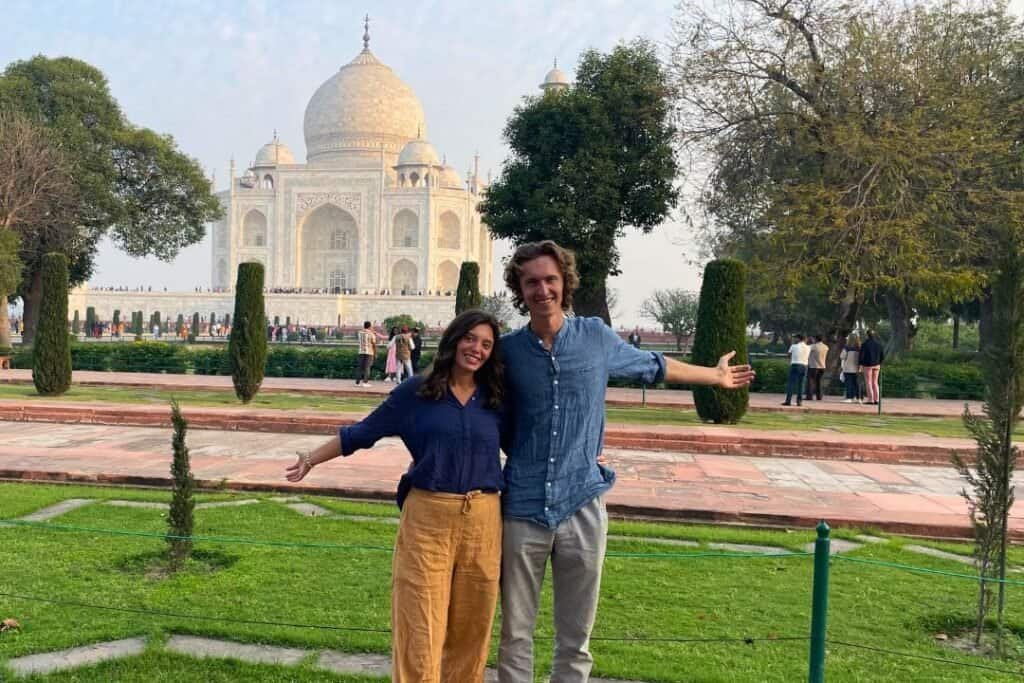
This blog is supported by the community. We may earn a small commission if you purchase through our links. As an Amazon Associate, we earn from qualifying purchases. See our Privacy Policy.
India for Backpackers Guide 2025
The Route We Took: South India to North India (January to April)
We began our journey with two weeks in Sri Lanka before flying into Chennai and working our way north. We avoided the major cities and instead chose a route that centred more around well-known ashrams to smaller ones, nature trips, and places with ancient temples. Here is our India travel guide of where we went and why we loved it.
Our India travel route:
Chennai → Pondicherry → Auroville → Coimbatore (Isha) → Varkala → Neyyar Dam → Sivananda Ashram → Kanyakumari → Munnar → Kochi → North Goa → South Goa → Jaipur → Agra → Rishikesh
Below is each stop – expanded with practical details, costs, transport notes, and cultural highlights.
India Backpacking Route Google Maps
India Travel Places
Tamil Nadu: Temples, Ashrams & Conscious Communities
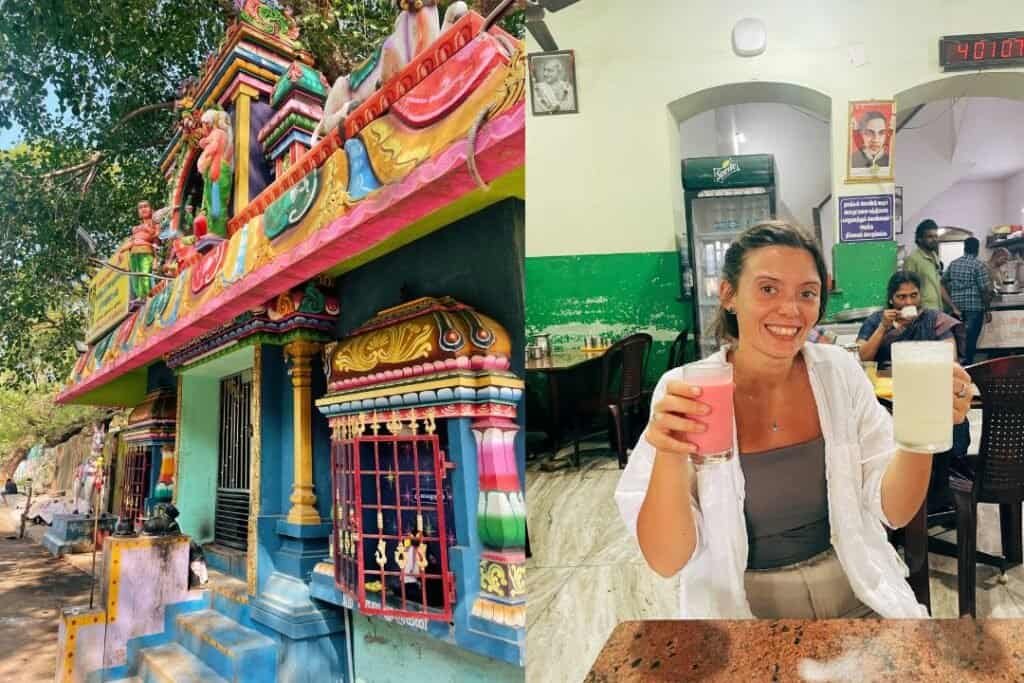
Pondicherry
Chennai → Pondicherry (4–5 hours by taxi or bus)
Pondicherry was the first place we visited after flying into Chennai. The city still carries its French colonial influence, pastel buildings, wide boulevards, and bakeries selling pastries. You’ll see street vendors selling chai next to French cafés and hear a mix of Tamil, English, and French as you walk along the seaside promenade. It’s an easy place to adjust to India’s pace without feeling overwhelmed, especially if it’s your first stop. Accommodation is affordable, ranging from simple guesthouses around $10–$20 USD to boutique hotels starting around $40 USD.
We spent days wandering the French Quarter, exploring small boutiques, drinking iced coffees in artsy cafés, and visiting the Sri Aurobindo Ashram, one of the most peaceful places in town. Pondicherry is also a great food destination, with South Indian thalis for $2–$3, fresh seafood on the beach road, and European-style restaurants if you’re craving comfort food. The evenings are especially lovely here, with locals and families gathering along the promenade for sunset. Compared to big Indian cities, Pondicherry has a slower and calmer feel.
Top Things to Do: Pondicherry
- Walk the French Quarter and seaside promenade
- Visit Sri Aurobindo Ashram
- Café-hop for excellent coffee, bakeries, and brunch
- Explore the Tamil Quarter markets and handicraft shops
- Sunset at Rock Beach
Auroville
After a few days on the coast, we took a tuk-tuk inland to Auroville, a community focused on sustainability, spirituality, and collective living. Auroville is unlike anywhere else in India, with quiet roads lined with red earth, banyan trees overhead, and eco-homes hidden among the forest. Instead of hotels, you stay in guesthouses within the community. We spent our days biking between cafés, attending sound baths, exploring quiet forest paths, and visiting workshops that teach everything from permaculture to philosophy. A highlight was meditating inside the Matrimandir, the golden spiritual sphere at the heart of Auroville. To enter, you must get a pass in advance, but it’s a serene experience worth the effort.
Auroville is also one of the best places in India for wellness travelers, vegan cafés, organic markets, yoga studios, meditation domes, and community events. Prices are slightly higher than the rest of India (meals around $4–$8 USD), but you’re paying for quality, organic produce, and ethically run spaces. It’s a place that attracts long-term travelers, artists, conscious backpackers, and people seeking a break from the noise of traditional travel.

Why you should visit Auroville
Auroville sits inland from Pondicherry and is unlike anywhere else in India. Founded as a community based on human unity, ecological living, and spiritual growth, it attracts travelers interested in yoga, meditation, sustainability, and intentional living.
The community is large, spread out across forested land. You’ll find:
• Organic farms
• Vegan cafés
• Meditation halls
• Sound baths
• Workshops on conscious living
• Cycling paths
• Beautiful guesthouses
We stayed in a guesthouse inside Auroville, which meant we could live like residents and definitely recommend booking this in advance. We meditated at the Matrimandir, attended workshops, practiced yoga, and spent evenings with new friends we met who were living there.
Costs:
Guesthouses: $15–$30
Meals: $3–$6
Scooter rental: $4–$6 per day
Top Things to Do:
- Meditate inside the Matrimandir (book in advance)
- Visit the Visitor’s Centre for Auroville’s history and philosophy
- Eat at organic, community-run cafés
- Explore cycling trails through the forest belt
- Attend sound healing sessions, workshops, and yoga classes
Isha, Coimbatore: Sadhguru’s Ashram
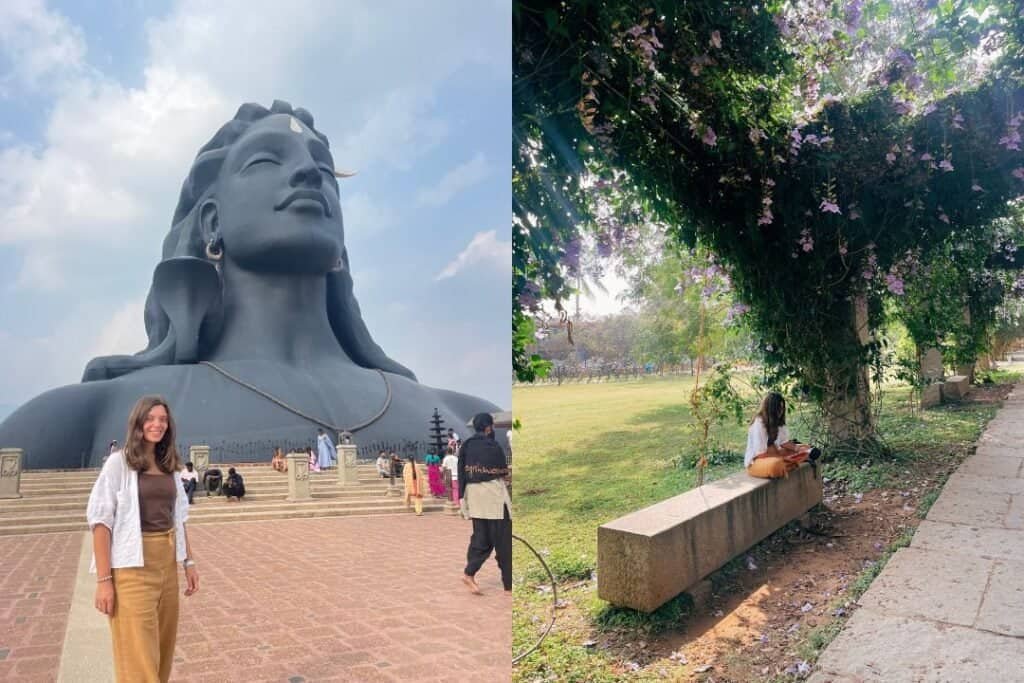
Coimbatore → Isha (1 hour by taxi)
Next, we flew west to Coimbatore and visited Sadhguru’s Isha Foundation for one week. Whether or not you follow his teachings, the ashram is a place of profound energy. We spent a full week immersed in trying to learn from others and their yoga practice.
Isha Foundation sits at the base of the Velliangiri Mountains and is dedicated to yoga, meditation, and spiritual growth. During our week here, we spent hours each day meditating, attending satsangs, visiting the consecrated spaces, and exploring the gardens. The Dhyanalinga is silent and an interesting experience daily, as well as the Linga Bhairavi temple. The Adiyogi statue, the largest bust in the world, is another highlight. It’s a bust of lord Shiva, which has a light show every evening.
Meals are served twice daily, simple and sattvic, and were delicious. Plus, there is a café on-site that offers snacks and chai.
A one-week stay at the Isha Yoga Center in Coimbatore, India, costs approximately $325 to $350 USD (₹27,000) for a room with meals.
Top Things to Do: Isha (Coimbatore)
- Meditate in the Dhyanalinga dome
- Join morning and evening Satsang
- Visit the Adiyogi Shiva statue
- Explore the serene gardens and lotus pond
- Join a yoga or Inner Engineering introductory session
Kerala: One Month in the Backwaters, Ashrams, Beaches and Mountains

Varkala
Coimbatore → Varkala (overnight bus)
From Coimbatore, we took an overnight bus south to Varkala, a clifftop beach town in Kerala known for its dramatic coastline and laid-back traveler community. Varkala was our first introduction to Kerala and felt worlds away from Tamil Nadu, more humid, more tropical, and more relaxed. The main stretch sits atop a cliff overlooking the Arabian Sea, lined with cafés, juice bars, boutique shops, Ayurveda massage centers, and yoga studios. It’s one of the few beach towns in India where women can comfortably swim in bikinis without drawing attention, thanks to the steady flow of international travelers.
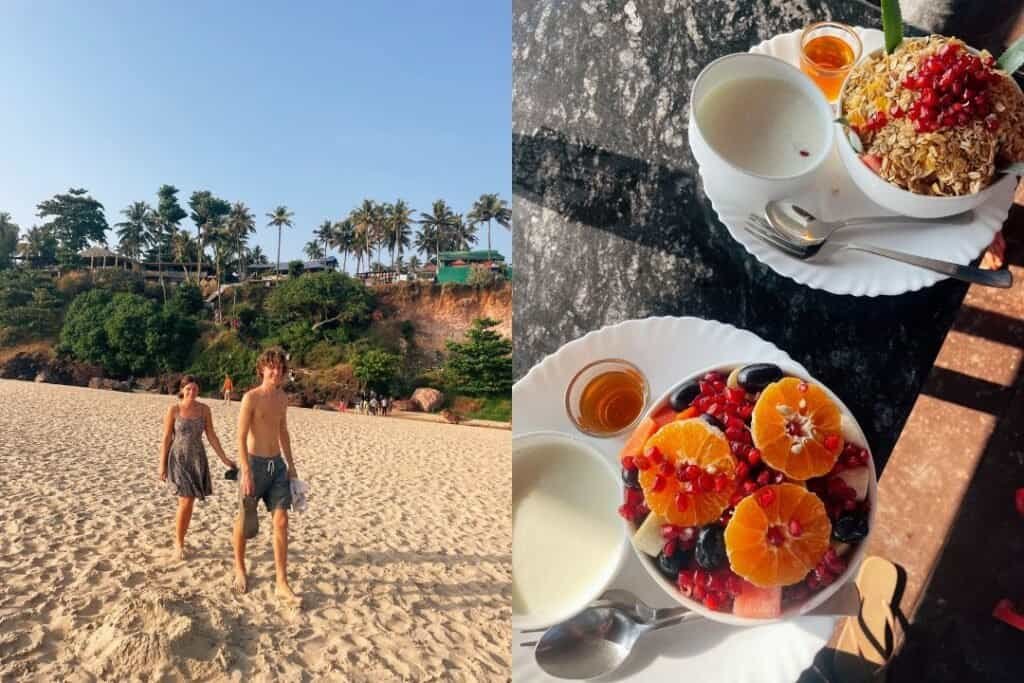
What to do:
Varkala is an easy place to slow down. Mornings are best spent doing yoga with an ocean view or grabbing a coffee at one of the cliff cafés. Afternoons are for sunbathing, swimming, or browsing the small shops selling handmade clothing, silver jewelry, and Ayurvedic products. Evenings tend to be calm, with sunset crowds gathering along the cliff before heading to dinner. Meals range from $2 for South Indian breakfasts to $6–$10 for Western-style café dishes. Accommodation is affordable, hostels and homestays range from $8–$15 USD, while boutique ocean-view stays start around $25.
Beyond the cliff, you can explore nearby beaches, visit the Varkala Temple, or join meditation or reiki sessions offered by local practitioners. If you want a gentle introduction to Kerala’s coastline and a chance to meet other travelers, Varkala is a great place to start.
We also went on a backwater kayak tour to visit for Kerala backwaters as we did not have time to do a houseboat tour there ourselves.
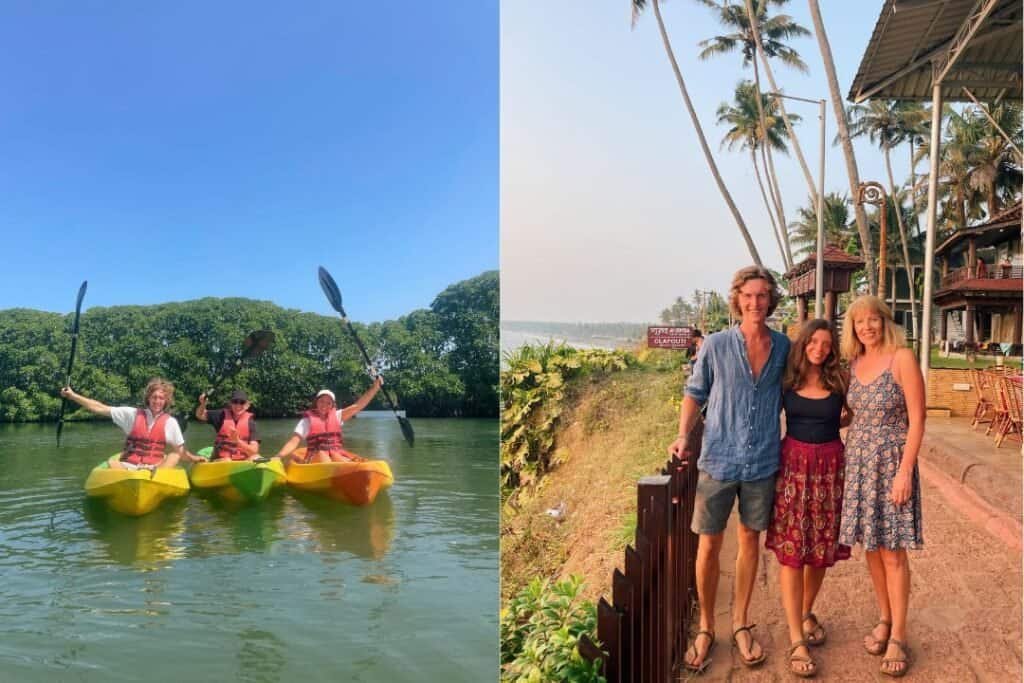
We then headed inland to Neyyar Dam, where we stayed at a homestay and took day trips to the misty Ponmudi Hills.
Top Things to Do:
- Relax on Varkala Cliff beaches
- Join daily yoga sessions overlooking the ocean
- Eat at cliffside cafés and seafood restaurants
- Visit Janardanaswamy Temple
- Explore nearby beaches by scooter
Ponmudi & Neyyar Dam
Ponmudi is a quiet hill station tucked into the Western Ghats and only a short ride from Neyyar Dam. We stayed in a homestay near the dam and used it as a base to explore Ponmudi, before heading into the intensity and structure of Sivananda Ashram. A day trip here usually includes driving the iconic 22 hairpin bends up to the viewpoint, passing tea gardens, small villages, and forest stretches filled with monkeys.
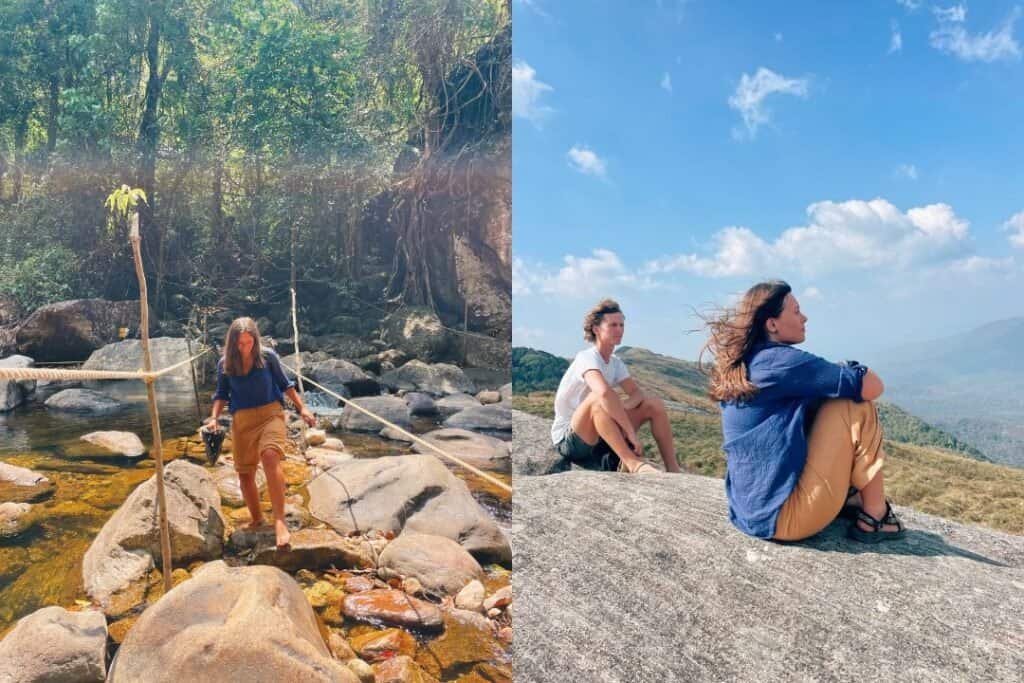
Many travelers stay at homestays, which usually cost $10–$20 USD per night with home-cooked meals available. Tuk-tuks are the easiest way to move around, and drivers are used to transporting visitors up to Ponmudi
Top Things to Do: Neyyar Dam & Ponmudi
- Take a day trip to Ponmudi Hill Station
- Visit the dam viewpoint and reservoir
- Go on nature walks around Neyyar Wildlife Sanctuary
- Stay in local homestays for authentic experiences
- Enjoy quiet lakeside sunsets
Sivananda Ashram, Neyyar Dam

Next came one of the most meaningful parts of our India trip: a two-week stay at the Sivananda Yoga Ashram in Neyyar Dam. This ashram attracts travelers from around the world looking for yoga and deeper spiritual study. Days begin at 6 AM with morning satsang, meditation, chanting, and talks, followed by asana practice. Meals are vegetarian and eaten in silence, and the schedule is full, whether you’re part of the yoga course or the Ayurveda wellness program. Every day includes:
• Morning satsang
• Asana practice
• Karma yoga
• Lectures
• Afternoon yoga
• Evening satsang
We joined the two-week Ayurveda Wellness Course ($1050), which happens every November and February, which included daily lectures on Ayurvedic principles, hands-on practical lessons, and yoga classes. It’s one of the best places to deepen your understanding of yoga and Ayurveda with authentic teachings. The community aspect is also strong in the course; we made friends who we still speak to today.
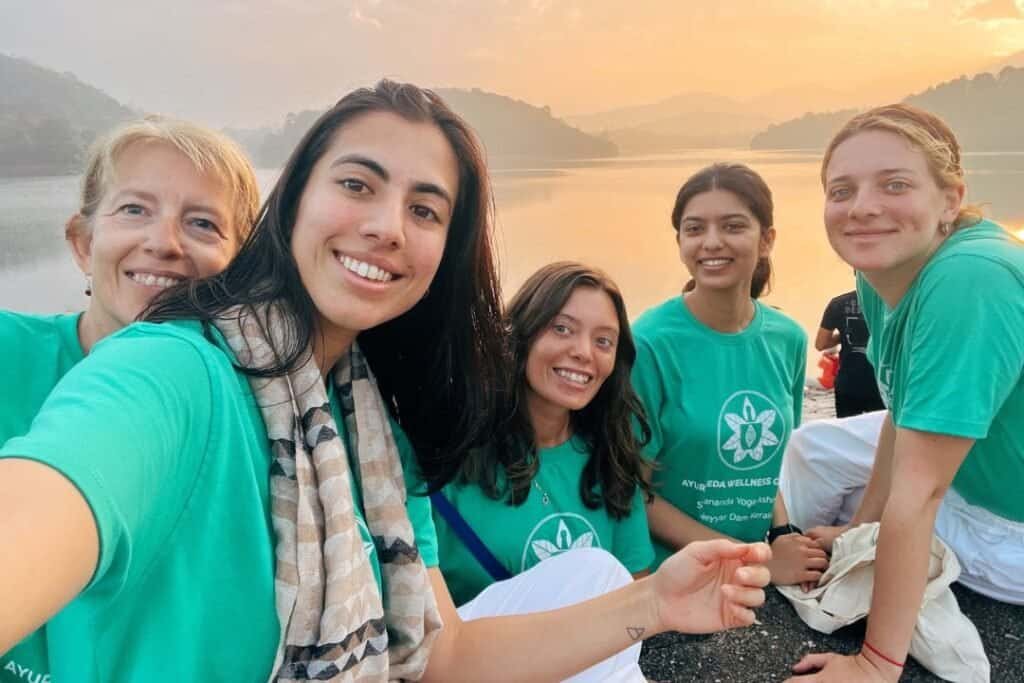
Accommodation ranges from shared dorms ($10 USD per night) to private rooms ($15–$25). The ashram is well-maintained, safe for solo women, and structured enough to support total beginners. It’s a great environment to reset physically and mentally before continuing your travels through India.
Kanyakumari & Thanumalayan Temple
As part of our course at the ashram, we went on a day trip to visit Kanyakumari, the southernmost tip of India, which is one of those places where geography, spirituality, and culture come together. It’s the meeting point of the Indian Ocean, the Arabian Sea, and the Bay of Bengal, and you can literally see the colors of the waters change where the three merge.
Kanyakumari itself has several other highlights: the Vivekananda Rock Memorial, accessible by ferry; the Thiruvalluvar Statue; and the quiet stretches of seaside promenade. Budget accommodation ranges from $8–$20 USD, while mid-range hotels sit between $30–$50. Local vegetarian meals at casual restaurants cost $1–$3 USD. It’s an easy day trip from Trivandrum or a restful overnight stop if you’re curious to see southern India’s spiritual roots without the intensity of larger temple cities. For anyone interested in sacred sites, sunrise rituals, and architecture, Kanyakumari and Thanumalayan Temple are well worth adding to your itinerary.
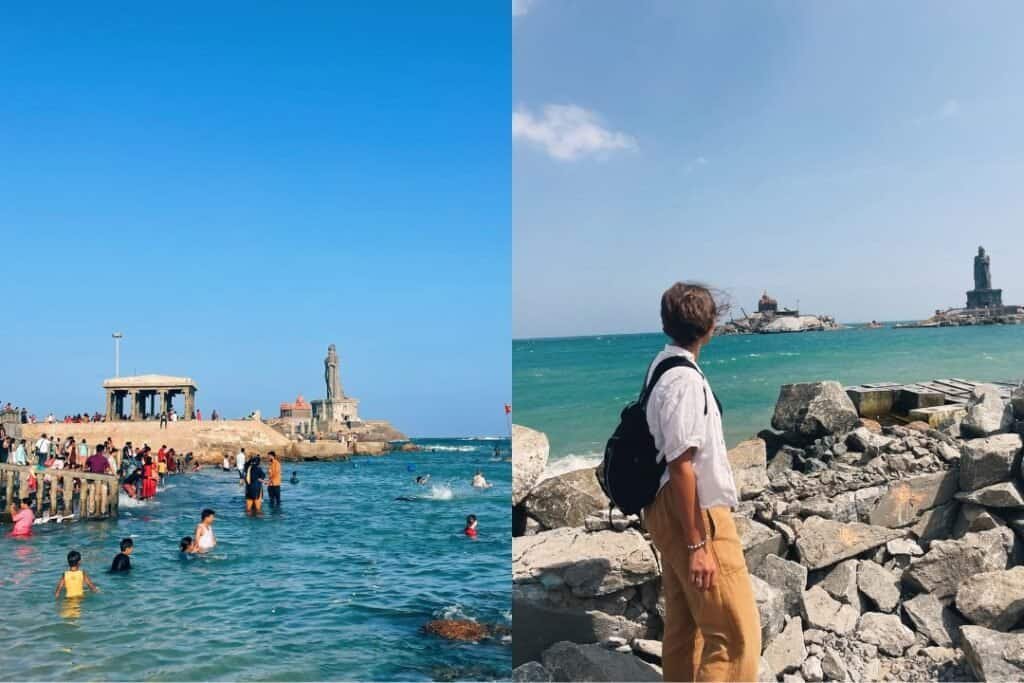
One of the most important landmarks in the area is the Thanumalayan Temple in the nearby town of Suchindram. This temple is architecturally stunning, known for its towering gopuram covered in detailed carvings and its rare dedication to the Hindu trinity of Brahma, Vishnu, and Shiva. Inside, you’ll find elaborate stone pillars, shrines, and sacred bathing tanks that reflect centuries of devotional tradition. Foreign visitors are welcome, though modest clothing is essential, and photography is often restricted inside the inner sanctum. The temple is active, with ceremonies, music, and bells, and offers a glimpse into the living spiritual culture of Tamil Nadu. We were extremely touched and in awe of how truly ancient the temple was. It is definitely worth a visit.
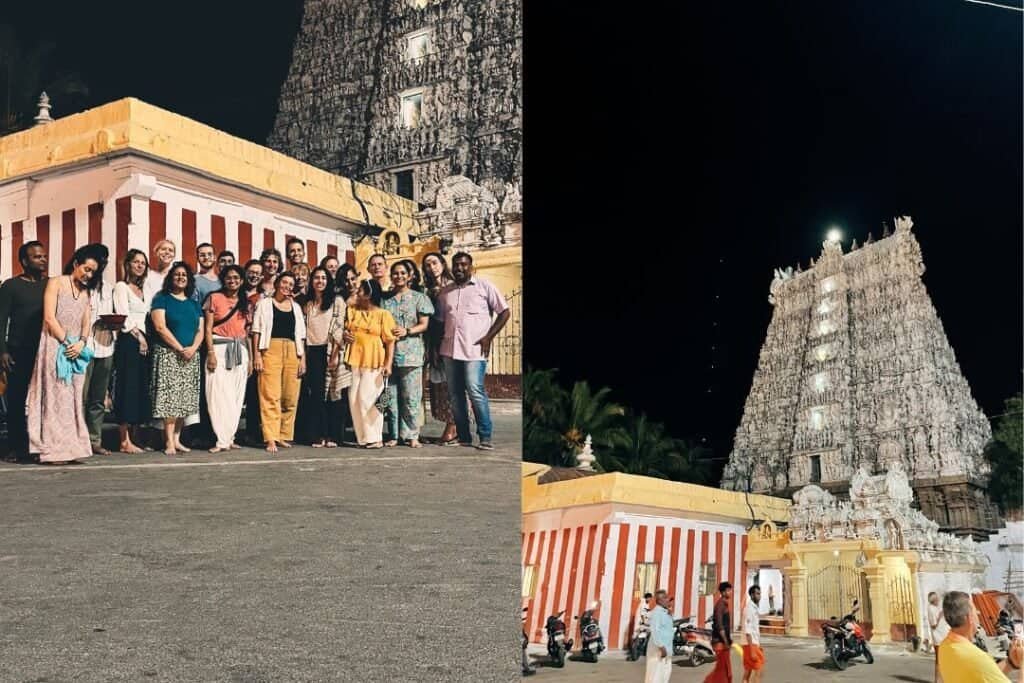
Top Things to Do: Kanyakumari
- Watch sunrise and sunset where three seas meet
- Visit Vivekananda Rock Memorial
- Explore the Gandhi Memorial
- Climb the lighthouse for panoramic ocean views
- Walk the beachside markets
Kovalam
We visited Kovalam on another day trip from the ashram. Kovalam is one of Kerala’s most established beach destinations, located just 30 minutes from Trivandrum and easily accessible whether you’re heading north or south along the coast. Although more built-up than Varkala, it still offers peaceful stretches of beach, warm water for swimming, and a relaxed environment ideal for rest and recovery between bigger travel legs. Lighthouse Beach is the most popular area, with small guesthouses, ayurvedic centers, and cafés lining the long crescent-shaped bay. Early mornings are especially calm, with fishermen pulling in their nets and the lighthouse casting soft light over the shoreline.
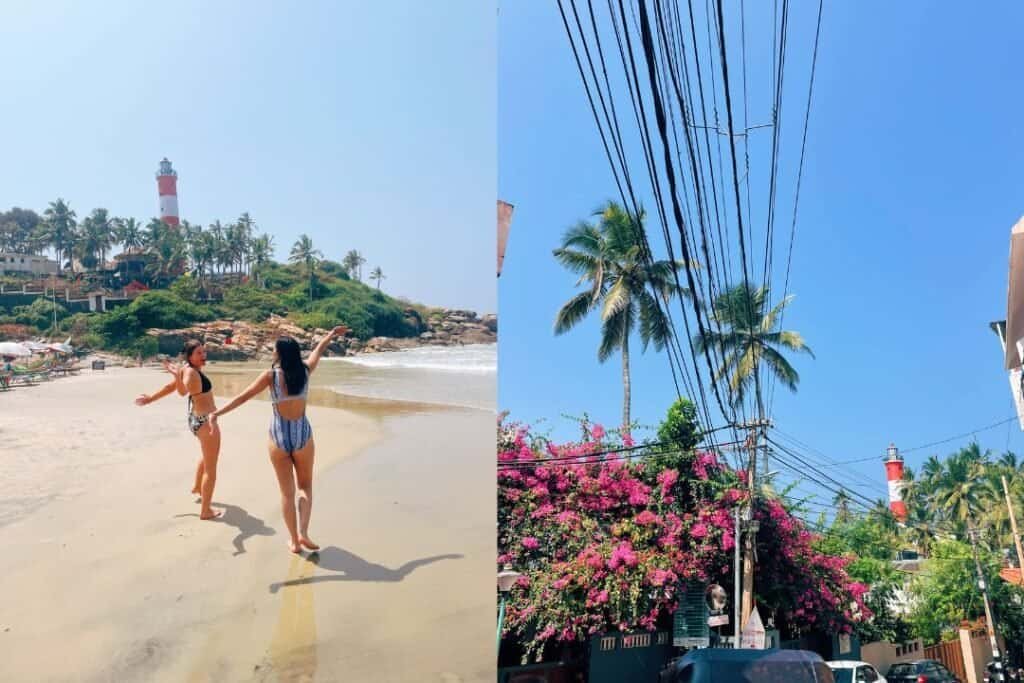
Kovalam is also one of the best places in South India for Ayurvedic treatments. From massage and detox programs to week-long wellness stays. Many travelers come here specifically for traditional therapies, and the quality ranges widely, so it’s worth reading reviews and choosing centers with certified practitioners. Yoga classes are available at most guesthouses, and the gentle slope of the beach makes it ideal for long walks and slow-paced days. Compared to the cliffs of Varkala or the mountains of Munnar, Kovalam is a place to unwind rather than explore intensively. Kovalam is an ideal endpoint for travelers who want to slow down, integrate their experiences, and enjoy a soft landing before continuing through Kerala or flying onward.
Top Things to Do: Kovalam
- Relax on Lighthouse and Hawa Beach
- Visit the lighthouse for coastal views
- Try surfing or swimming in calmer areas
- Enjoy Ayurvedic massages and treatments
Munnar

Neyyar Dam → Munnar (6–7 hours by bus or taxi)
Munnar, tucked high in the Western Ghats of Kerala, was one of the most refreshing parts of our India route -both literally and figuratively. After weeks in warm coastal regions and the structure of ashrams, arriving in the cool mountain air felt grounding and restorative. Munnar is often called the “tea capital” of South India, and everywhere you look, the hills ripple into green patterns of perfectly trimmed tea bushes. It’s peaceful, scenic, and ideal for travelers who want nature, hiking, and slow days surrounded by fresh air.
We spent four days here, which felt like the right amount of time to unwind and explore without rushing. The climate is mild, making it a popular holiday destination for Indian families escaping the heat, but it still maintains a relaxed feel. Most travelers stay near Old Munnar or in homestays on the outskirts, where the mountain views are at their best. Our accommodation arranged a local driver and jeep for a full-day trip, and it ended up being one of our best days in Kerala, relaxed, scenic, and full of stops we wouldn’t have known about on our own.
What to do in Munnar
Exploring the tea plantations is essential. Munnar is home to vast estates, many dating back to the British colonial era. You can visit tea factories, learn about the production process, and sample different varieties. The Tata Tea Museum is one of the most accessible options and offers insight into the region’s history. But the real magic is walking along the estate paths early in the morning when the mist lifts off the hills, the air is crisp, and the light is soft. Some plantations allow guided sunrise walks, a great experience for photographers or anyone who enjoys quiet mornings.
There are plenty of outdoor activities too. Popular spots include Top Station for panoramic views of the Western Ghats, Echo Point for its lake and forest setting, and Attukad Waterfall, which is especially beautiful during and just after monsoon season. Hiking opportunities range from light nature trails to more challenging treks like Meesapulimala, the second-highest peak in South India. Many treks require a guide and permits, which your accommodation can easily arrange. There are also the traditional Kathakali dance shows for indoor entertainment.
Munnar is also a great place for wildlife lovers. The Eravikulam National Park, home to the endangered Nilgiri tahr, offers stunning mountain landscapes and is known for the Neelakurinji flowers that bloom once every 12 years. Entry is around $3–$6 USD depending on nationality, and the park is well-organised with shuttle buses to the top viewpoints. For wellness and food, most cafés serve hearty Keralan meals such as thali, dosa, and vegetable curries, with prices around $2–$5. If you’re travelling as a wellness-focused backpacker, choose homestays; many offer homemade food, nearby nature walks, and quieter surroundings than town centres.
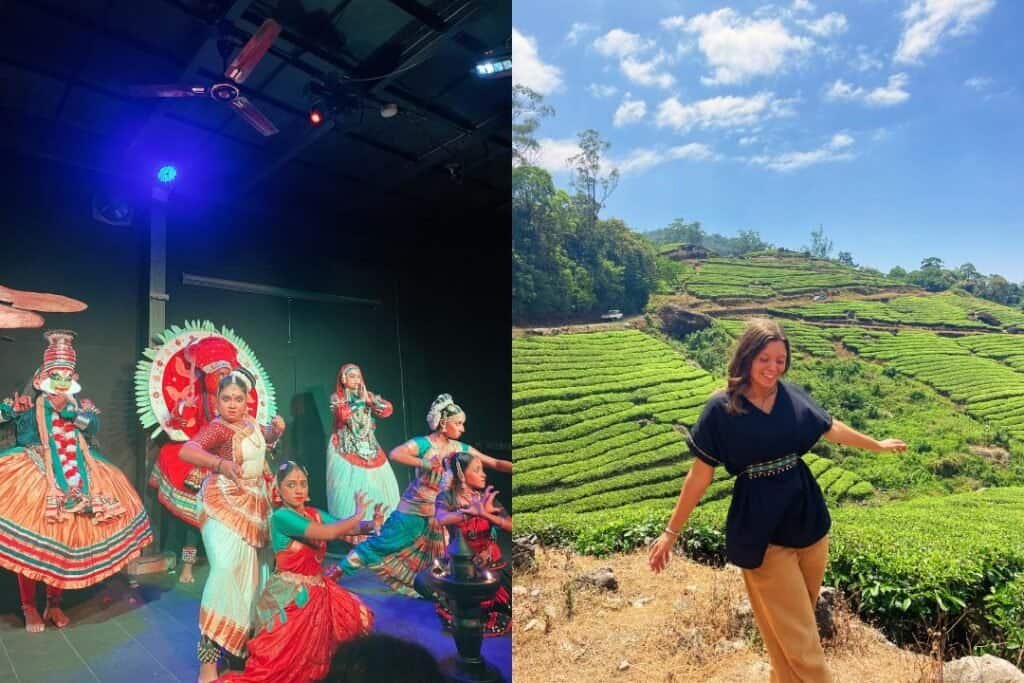
Getting Around Munnar
Getting around Munnar is easiest with a driver or jeep hire for the day, costing around $20–$35 USD depending on distance. Public transport exists, but routes are limited and time-consuming. Scooter rentals are available but not recommended unless you’re an experienced rider; the roads are steep, narrow, and winding. Accommodation ranges from $12–$20 for basic homestays, $25–$40 for scenic mid-range guesthouses, and $50–$100 for boutique mountain lodges.
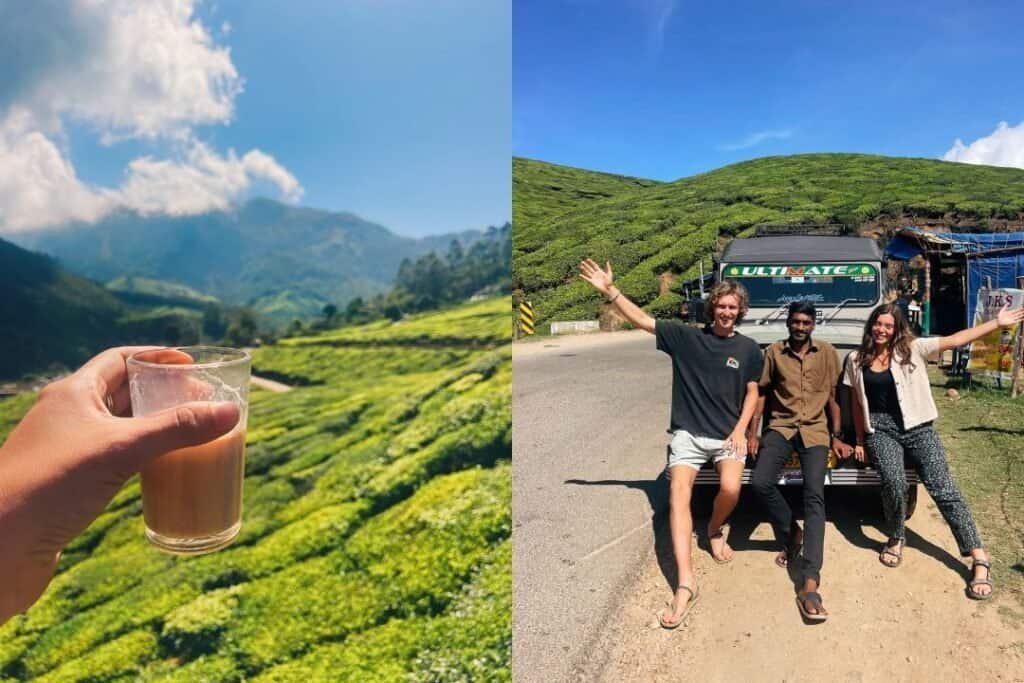
Top Things to Do: Munnar
- Visit tea plantations and the Tea Museum
- Jeep tour to Top Station or Kolukkumalai sunrise viewpoint
- Hike in Eravikulam National Park
- Attend a traditional Kathakali dance show
- Explore waterfalls like Lakkam and Attukal
- Visit spice gardens and sample local chocolate and tea
Kochi
Kochi, also known as Cochin, is often the first major stop for travelers in Kerala, and it’s one of the easiest cities in India to warm up to. We only spent one day and one night here before heading to the airport to fly to Goa.
It’s calmer than big metropolitan hubs, walkable, and full of history. The city is divided between mainland Ernakulam and the historic peninsula of Fort Kochi, where most travelers stay. Fort Kochi feels more like a cultural pocket than a traditional city quiet streets lined with colonial buildings, independent cafés, art galleries, and shaded courtyards.
The heart of Fort Kochi is its layered history. This small port has been shaped by Portuguese, Dutch, and British influences, and you see it everywhere, in the churches, architecture, street names, and local cuisine. The iconic Chinese fishing nets, standing tall along the shoreline, are one of Kochi’s most photographed sights. For backpackers, Kochi is easy to enjoy on foot, and accommodation is wide-ranging: homestays around $12–$20 USD, boutique guesthouses $25–$45 USD, and higher-end heritage hotels from $60+.
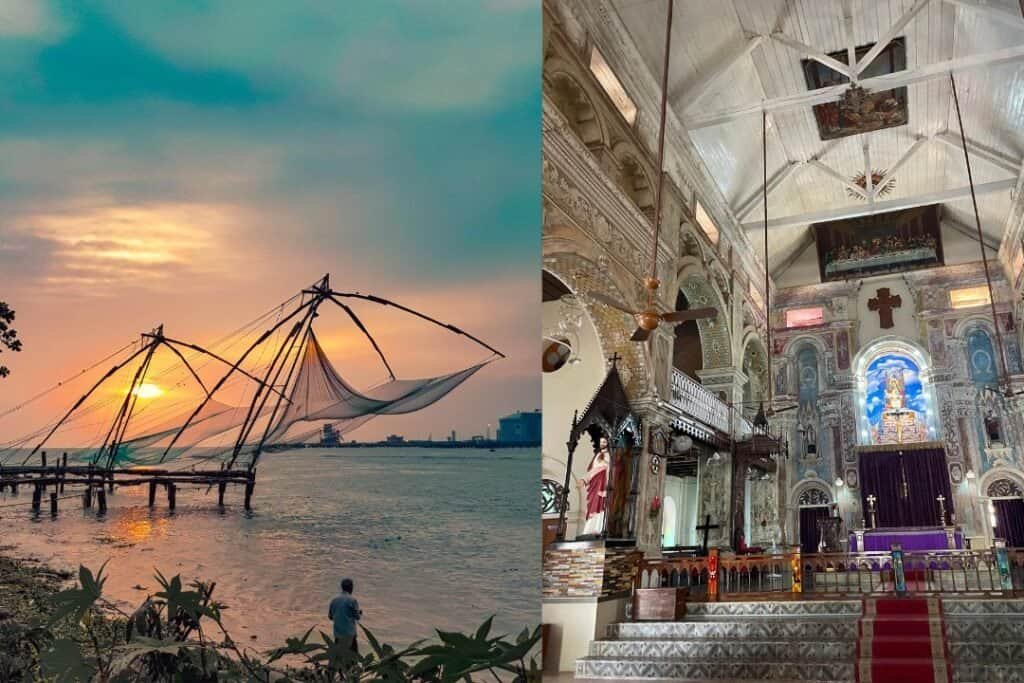
Across the water in Ernakulam, you’ll find the more modern side of Kochi, shopping malls, markets, and ferry links. Taking one of the local ferries between Fort Kochi, Vypin, and Ernakulam is not only practical (tickets cost less than $0.10 USD) but also gives you a fun local experience. Kochi is also a fantastic base for day trips: head to Cherai Beach for a quieter coastal day, visit the Kerala Folklore Museum for culture and dance performances, or take a taxi to Alleppey to experience the backwaters (2 hours away).
Top Things to Do:
- Explore Fort Kochi on foot
- See Chinese fishing nets at sunset
- Visit Santa Cruz Cathedral Basilica, Mattancherry Palace, and Jewish Synagogue
- Café-hop and wander local art galleries
- Take the local ferry to Ernakulam
Goa: Party North, Peaceful South
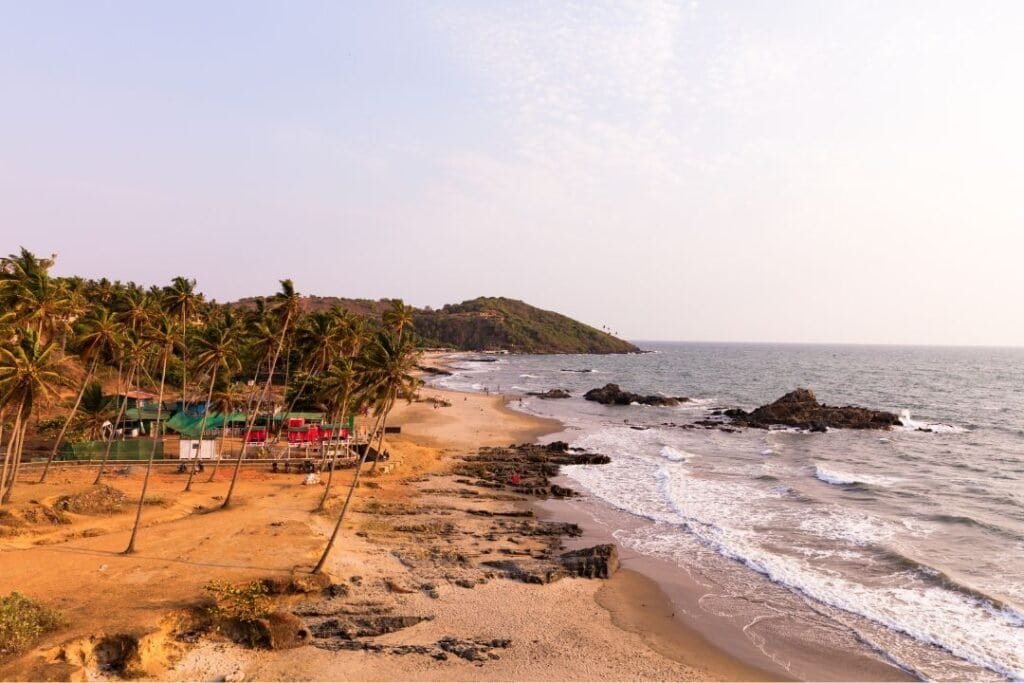
North Goa
We took a flight from Kochi to Goa. North Goa often appears in travel searches as one of the most lively places, especially for nightlife and beach parties. We decided to visit out of curiosity, and while it wasn’t fully aligned with our interests, it was fun to see a different side to India. The beaches here, Baga, Calangute, Anjuna, Vagator, are wide and busy. Beach clubs line the sand, music plays late into the night, and travelers flock here for cheap drinks and social energy. For party-focused backpackers or travelers seeking the iconic “Goa rave scene,” North Goa delivers exactly that.
However, for nature-focused or wellness-oriented travelers, North Goa can feel overwhelming. The beaches are more commercial, the streets are more crowded, and prices are slightly higher than the rest of Goa due to its popularity. That said, it’s a good place to spend a couple of nights if you want to experience this side of India before heading south for a more peaceful stay. If you do visit, cafés like Artjuna and Baba Au Rhum offer great breakfasts, good coffee, and relaxed atmospheres that feel worlds away from the beach crowds.
North Goa is also a good base for exploring local markets such as Anjuna Flea Market (Wednesdays) and the colourful Arpora Saturday Night Market. These markets sell everything from handmade jewellery to Ayurvedic oils, spices, homeware, clothes, and food stalls featuring global and Indian cuisine. Scooters cost around $6–$8 per day to rent, and taxis or tuk-tuks are easily available but pricier.
Top Things to Do: North Goa
- Visit Anjuna, Vagator, and Arambol beaches
- Explore flea markets and night markets
- Visit Chapora Fort
- Join beach parties and live music scenes
- Try local street food and Goan curries
South Goa

South Goa is where Goa truly shines, especially for nature, wellness, and chill travel. This region draws travelers looking for quiet beaches, sunrise yoga classes, clean cafés, and days that move gently and predictably. The beaches in the south, Palolem, Agonda, Patnem, Colomb, are calm and far less commercial than the north. You’ll find long stretches of sand, palms, small restaurants serving wholesome food, and a more grounded backpacker scene.
One of the best places to stay is Bhakti Kutir, an eco-friendly retreat with rustic huts, palm-shaded paths, yoga sessions, cacao ceremonies, and community events. It attracts conscious travellers, solo backpackers, and anyone wanting a blend of nature and social connection.

South Goa also has some of the best health-focused cafés in India. Try Zest for vegan and vegetarian meals, Little World for chai and breakfast plates, and Café Inn for relaxed brunches. For activities, you can kayak along the coastline, take a boat trip to Butterfly Beach, or hike to Cabo de Rama Fort for panoramic cliff views. Prices are still very affordable compared with Western destinations: huts range from $15–$40, meals cost $3–$8, and yoga classes run $8–$12.
Top Things to Do: South Goa
- Relax on Agonda or Palolem Beach
- Join yoga classes, cacao ceremonies, and sound healings
- Visit Cotigao Wildlife Sanctuary
- Stay in rustic beach huts or eco-retreats
The Golden Triangle: Jaipur, and the Taj Mahal

Jaipur
Jaipur, the Pink City of Rajasthan, is often listed among the best places to travel in India thanks to its mix of history, architecture, shopping, and food culture. After weeks in nature and quiet towns, arriving in Jaipur, we were met with bustling streets, bazaars full of textiles and spices, pink-washed buildings, and rickshaws weaving through traffic. Even so, it remains one of India’s most culturally rich cities and an excellent entry to the north.
One of the highlights is the Amber Fort, a hilltop fortress with courtyards, intricate carvings, mirrored halls, and sweeping desert views. You can easily spend half a day here. Don’t miss the City Palace, still partly home to Jaipur’s royal family, and the iconic Hawa Mahal, a honeycomb-like pink structure built for royal women to observe the city unseen. The Jantar Mantar, an ancient astronomical observatory, is another UNESCO site worth visiting for its sheer uniqueness.
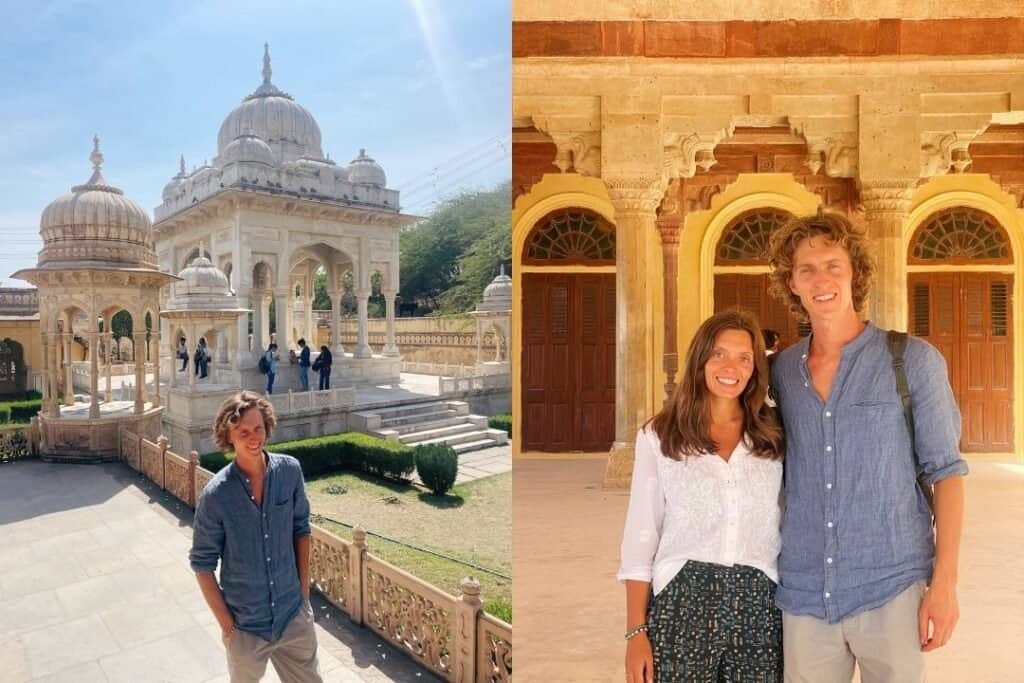
Jaipur also offers great food: try the thali at Thali House, lassi at Lassiwala, and Rajasthani dishes like dal baati churma. For shopping, the bazaars are filled with block-printed clothes, jewellery, leather goods, and handicrafts. Accommodation ranges from homestays around $15–$25 to boutique heritage hotels for $40–$80. Taxis, tuk-tuks, and ride apps like Uber are the easiest way to get around, though walking through the old city is part of the fun if you don’t mind the chaos.
Top Things to Do: Jaipur
- Visit Amer Fort at sunrise
- Laxmi Narayan Temple
- Explore Hawa Mahal and City Palace
- Wander the bazaars for textiles and jewelry
- Sunset at Nahargarh Fort
- Try traditional Rajasthani thali
Agra
Agra is almost always associated with the Taj Mahal, and rightly so, but the city itself is less compelling for travelers, so we recommend staying for one or two nights. The Taj Mahal, however, is reason enough to come. Visiting at sunrise is essential; arriving 30 minutes before opening allows you to walk into the grounds as the sky turns pastel and the marble glows with the first light. It’s quiet, peaceful, and incredibly atmospheric before the crowds arrive.
The Taj is symmetrical, elegant, and of course, a wonder of the world. Walking through the gardens, standing on the platform, and noticing the details carved into the marble makes the experience unforgettable. Afterward, you can visit Agra Fort, another UNESCO site, and Mehtab Bagh, a garden with a mirrored view of the Taj across the river.
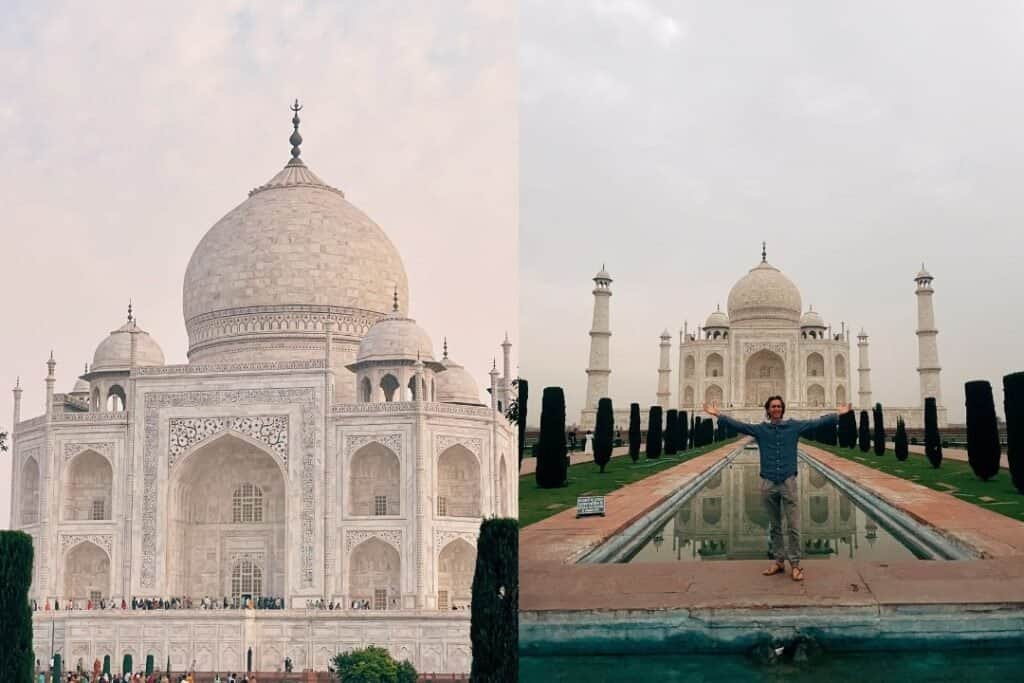
Aside from these landmarks, Agra has limited experiences for backpackers. Many travelers pass through quickly, taking the train to Delhi or Jaipur afterward, or in our case, a night bus to Rishikesh. Expect accommodation around $10–$20 for basic guesthouses and $40–$60 for pleasant boutique stays. Tuk-tuks are the easiest way to get around, and rides are affordable at $1–$3 per trip.
Top Things to Do: Agra
- Sunrise visit to the Taj Mahal
- Visit Agra Fort
- Explore Mehtab Bagh across the river
- Try Mughlai cuisine
- Visit marble handicraft workshops

Rishikesh: The Spiritual Capital of the World
Rishikesh is the final chapter of many India backpacking trips, a place where people stay for a week and end up staying for a month. Sitting at the foothills of the Himalayas and divided by the turquoise Ganga River, Rishikesh blends spirituality, yoga culture, outdoor adventure, and a lively backpacker scene. It’s one of the safest and most comfortable places for solo women, thanks to its alcohol-free laws, spiritual community, and abundance of ashrams.
We spent over three weeks between Aurovalley, Parmarth Niketan, and Tapovan. In Aurovalley, you’ll find peaceful gardens, daily meditations, and quiet reflection spaces. We first spent a few days in Aurovalley, the ashram related to Auroville, where the onsite guru Swami Brahmdev hosted Q and A sessions every day as well as group meditations.
After, we spent two weeks at a yoga course at the largest ashram in Rishikesh called Parmarth Niketan, attending classes and ending the day at Satsang with Pujya Sadhvi Bhagawati Saraswati. Parmarth Niketan offers structured courses, yoga classes, and nightly Ganga Aarti, a beautiful spiritual ritual on the river. Tapovan, the backpacker side, is full of cafés, healthy yogi foo,d as well as kombucha, and chocolate banana pancakes. Yoga studios line every street, offering everything from Ashtanga to Kundalini.
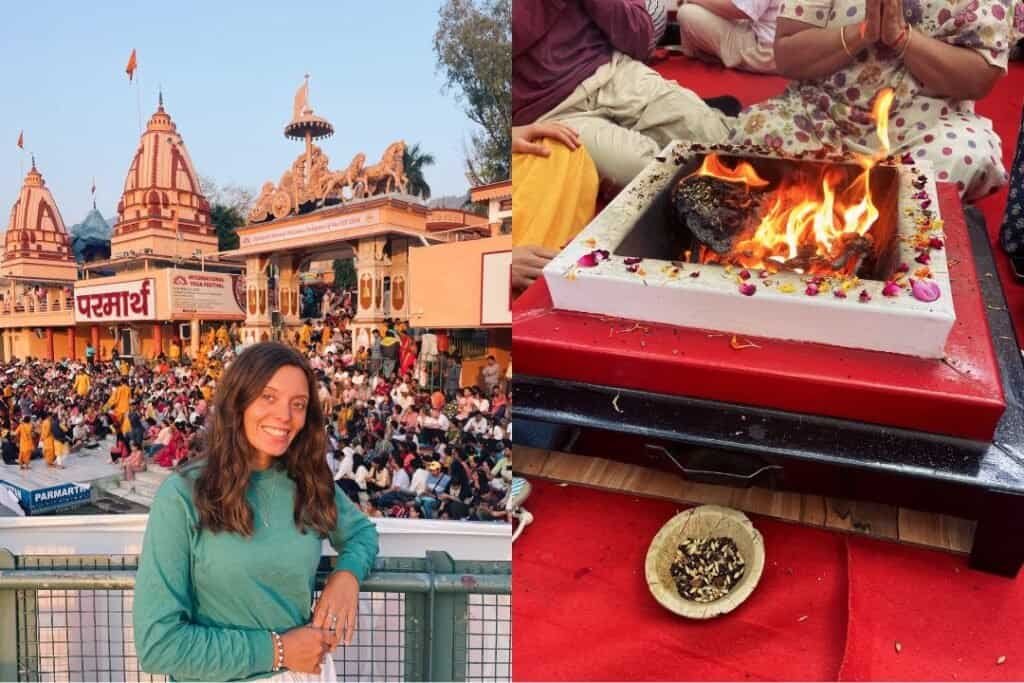
Tapovan
We spent the rest of the time in Tapovan attending more yoga classes, Ayurveda cafés, and hanging out in the town with a more youthful backpacking vibe. It was Holi festival when we were there, which was such a memorable experience. The celebrations often include throwing coloured powder and water on one another. Holi is celebrated on the last full moon of the lunar month, and Rishikesh, being a sober city, was a safe and enjoyable place to spend it.
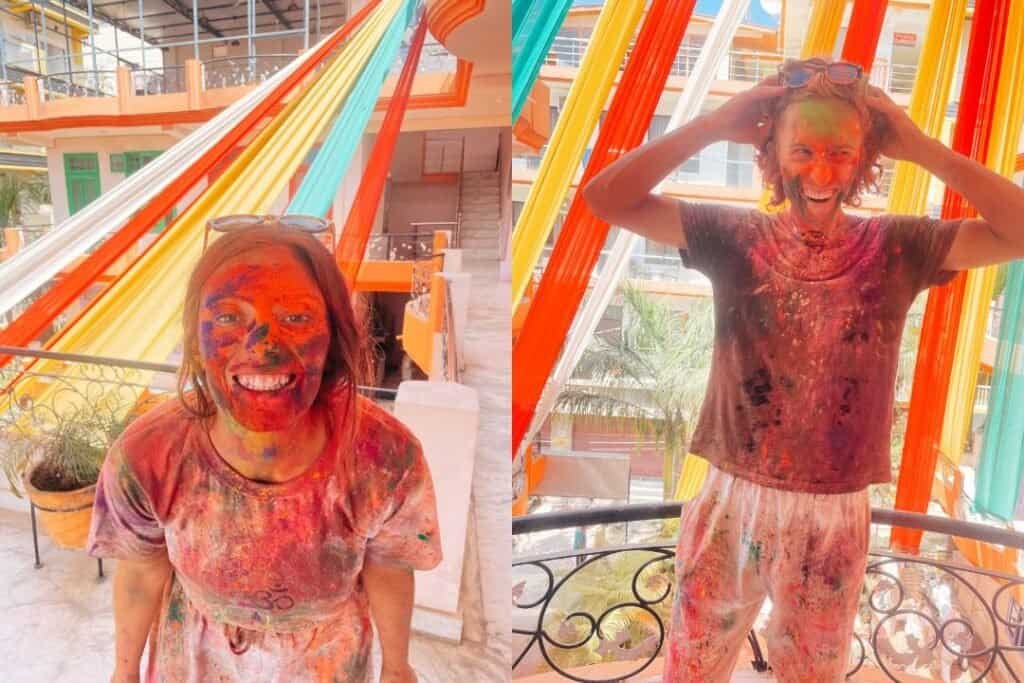
Rishikesh also has great nature escapes, waterfalls, river beaches, forest trails, and mountain viewpoints. Hostels cost $6–$12, ashrams range from $10–$25 with meals, and cafés serve meals for $3–$6. Scooters are less common here; walking and tuk-tuks are the main ways to get around. You can also join multi-day treks into the lower Himalayas, explore nearby villages and even camp.
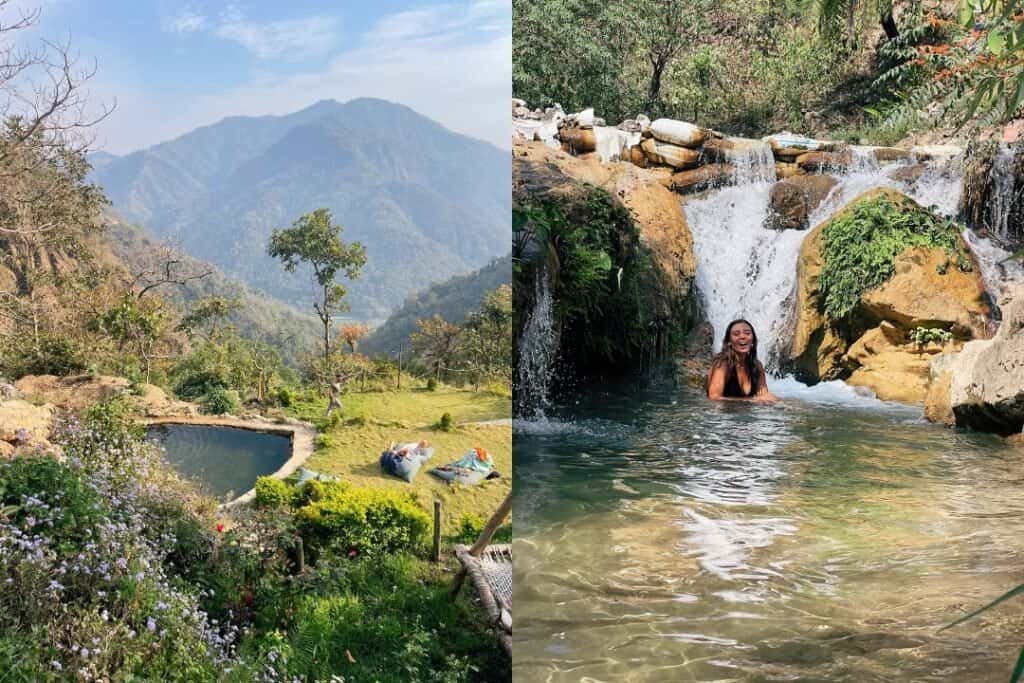
Following the time in the town and ashrams, we also spent a few days camping in the hills not far from Tapovan. Then a week on a Workaway, several hours from Rishikesh, tending to the cows, helping with the land, and even attending a school for an English class.
Top Things to Do: Rishikesh
- Attend Ganga Aarti at Parmarth Niketan
- Join yoga classes and workshops
- Walk across Ram Jhula and Laxman Jhula
- Visit nearby waterfalls and river beaches
- Café-hop in Tapovan, great for digital nomads

Backpacking Route Through India: Our Itinerary
4 days: Pondicherry — ease into India with Pondicherry’s French Quarter.
4 days: Auroville — explore conscious community living, meditation, and workshops.
1 week: Fly to Coimbatore to spend a week at Isha Yoga Center.
5 days : Go south to Varkala — unwind by the cliffs and beaches.
2 days : Move inland to Neyyar Dam — quiet homestays and nature.
2 weeks: Stay at Sivananda Ashram — a two-week immersion in yoga and Ayurveda.
4 days: Head to Munnar — tea plantations and cool mountain air.
2 days: Go to Kochi – Portuguese, Dutch, and British influences and iconic Chinese fishing nets
8 days: Fly to Goa : party in the north or retreat in the south.
3 days: Fly to Jaipur — forts, palaces, and pink city markets.
2 days: Take a bus to Agra — sunrise at the Taj Mahal.
3 weeks: Head north to Rishikesh — yoga, ashrams, and mountain life.
What We Packed for Four Months in India
We have a full India packing list for women guide if you are looking for more details. And as India spans climates and ecosystems, from hot beach towns to chilly Himalayan foothills, here is a quick run-through of what we recommend packing for a long-term trip. This list applies to both men and women:
- Lightweight natural fibre clothing (linen and cotton are your best friends)
- A scarf or shawl for temples and cooler mornings
- A good-quality yoga mat or travel mat
- A journal and a pen (you will want to reflect often)
- Loose trousers and modest tops for ashrams
- A solid water filter or purification drops, we used our Survivor Water Filter to drink from the tap.
- Lightweight hiking shoes and sandals (we brought barefoot shoes with us, which take up little space in our backpacks)
- Layered options for colder areas like Munnar and Rishikesh
- Refillable water bottle
- A few outfits such as a dress, long skirt or nice top for women for dressing up or cities
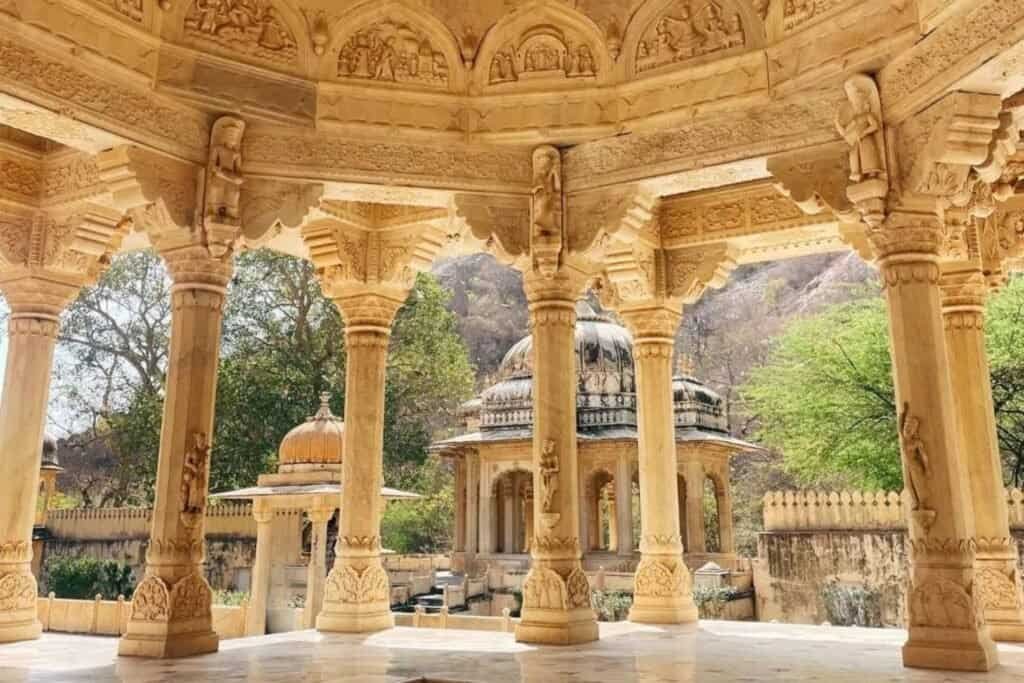
India Travel Guide 2025: What to Know Before You Go
India is vast, diverse, and incredibly affordable. Whether you are backpacking on $15–$25 a day or choosing mid-range or comfortable boutique stays, India can work for nearly any budget.
Below are a few essentials:
India Travel Visas
Most travelers need an e-visa, which you can apply for online.
The tourist e-visa typically comes in:
• 30-day
• 1-year
• 5-year options
Processing times vary from 48 hours to a week. Always apply through the official government website.
India Travel Adapter
India uses Type C, D, and M plugs. A universal travel adapter is essential.
India Travel Costs
India remains one of the best-value destinations in the world.
Budget travelers: $15–$35 per day
Mid-range travelers: $40–$80 per day
Boutique/luxury: $100–$300+ per day
Hostels: $6–$15
Ashrams: $10–$25 (often including meals)
Homestays: $15–$40
Domestic flights: $25–$80
Train rides: $1–$20 depending on class and distance
FAQ: India Travel Guide: Backpacking India
Is India safe for backpackers?
Yes, but it requires awareness and preparation. India is safe for most travellers, but it is important to stay street-smart, especially in busy cities. For solo women who are nervous about travelling alone, we met plenty of solo travellers and we did not hear of any issues. However, spending time in spiritual centres, ashrams, and backpacker towns such as Varkala can feel safer and more welcoming if you want to ease in.
Do I need to book everything in advance?
Not necessarily. India is a place where plans often shift. We recommend booking trains and flights a few weeks ahead, but you can be flexible with accommodation, especially if you are heading to less touristy places. Most of the time, the homestays and accommodations are extremely helpful, and it is much easier to book them there and then.
What is the best time of year to travel India?
November to March is ideal. You will avoid the monsoon and the scorching summer heat. If you are heading north to Rishikesh or the mountains, March to May is also lovely. We started from the beginning of January and left toward the end of April, when it was getting hot even in the Himalayas.
Can you do India without visiting big cities?
Absolutely. India’s beauty shines brightest in its smaller towns, nature retreats, and spiritual centres. Our entire route prioritised nature and smaller towns and it was magical. We did not visit many big cities for long, but we loved Jaipur and its gorgeous architecture so we would highly recommend that.
Enjoyed our guide? Read more Read more
The Ultimate India Packing List for Women
10 Best Spiritual Retreats in India 2025
The Perfect Two Week Sri Lanka Itinerary
The Best Travel Backpacks: The Ultimate Guide








